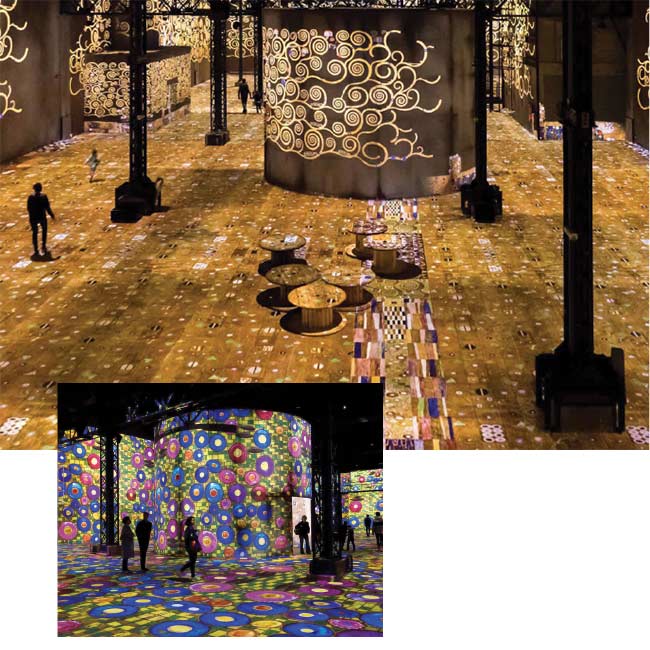
Immersive art, brilliantly lit
Immersive art exhibits are all the rage, offering museumgoers a way to step inside (so to speak) their favorite paintings. Not intended to replace conventional artwork but rather to complement it, these exhibits that merge art and digital technology can create links between eras, add dynamism to artistic practices, amplify emotions, and reach larger audiences than traditional museums.
The Atelier des Lumières, Paris’ first digital art center, opened recently thanks to Culturespaces, a private cultural operator that manages monuments, museums, and art centers.

The immersive exhibition "Gustav Klimt". Courtesy of Atelier des Lumières/Culturespaces/Eric Spiller.
With 140 BARCO high-power laser video projectors interconnected by fiber optics to a battery of computers and a spatialized sound system, Atelier des Lumières offers patrons a truly immersive art experience. The exhibit, housed in a foundry that dates back to 1835, features the artwork of Austrian symbolist painter Gustav Klimt and his protégé Egon Schiele. Klimt led the Vienna Secession, a movement that sought to break away from academic art. Filled with symbolism, Klimt’s oeuvre was incorporated into the new architecture of the Secession Palace and can now be seen on the Atelier’s monumental walls. In the exhibition, the allegorical figures gradually emerge, reproducing the entirety of the work and its wealth of detail.
The exhibition also features Friedensreich Hundertwasser, another artist who symbolized Viennese creativity. And visitors will get to step into the artwork of up-and-coming artists in an area devoted to digital artists and their contemporary art.
“I want visitors to enjoy an immersive and sensorial artistic experience because people do not learn about culture as they did in the past. The practices are evolving and the cultural offering must be in step with them,” said Bruno Monnier, president of Culturespaces. “The marriage of art and digital technology is, in my opinion, the future of the dissemination of art among future generations.”
More than 3000 moving images are projected over a total surface area of 3300 sq m. These images extend from the floors to the ceilings and cover walls up to 10 m high, making it one of the largest fixed multimedia installations in the world.
Monnier told Photonics Media that Atelier des Lumières combines music and aesthetic pleasure — in the form of projected images and artwork — and lets patrons discover art from a new angle.
“Immersive exhibitions can bring the younger generation and the uninitiated to appreciate art and make them want to extend the visit to the museum,” he said. “The projection of extremely large images of works enables the visitor to be completely immersed.”
Monnier and Culturespaces plan to present one exhibition, focusing on great figures in the history of art cycle, each year in the Atelier des Lumières. Their next exhibition will focus on the early modernist Marc Chagall.
Digital art is taking over mainstream art and Culturespaces is right in the middle of it, developing activity in other cities and abroad. At the end of the year, a similar digital art center will open in South Korea. In 2020, Culturespaces plans to open a site in Bordeaux, France, and another in Minneapolis is in the works, which will allow more patrons to be completely immersed in their favorite art.
Published: September 2018